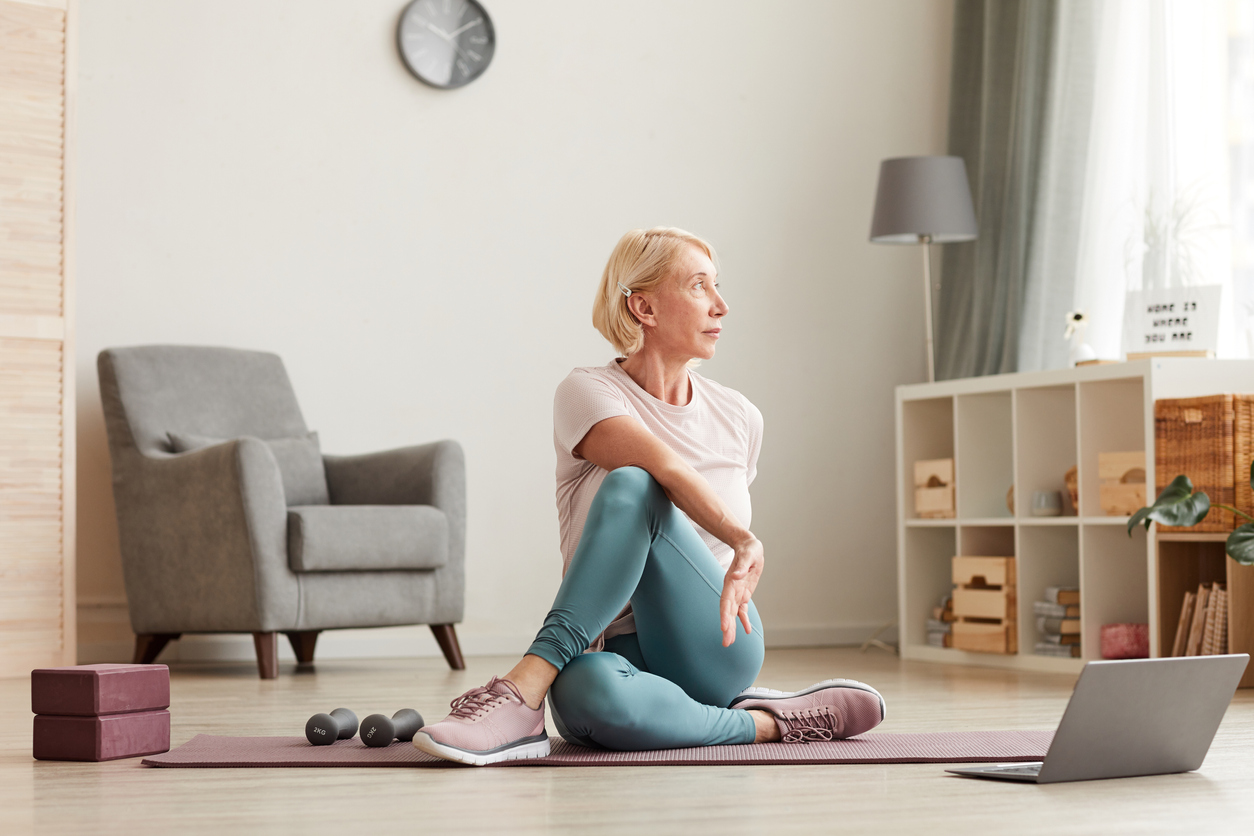Yoga vs. Meditation: Can You Benefit from a Daily Practice?

Senior woman sitting on the floor on exercise mat in front of laptop and training at home
Yoga and meditation have been practiced for thousands of years, and the two of them are generally used together. Together they are being used as another form of exercising. The following are some of the benefits of yoga is that it is a means in which helps in keeping both the mind and body in a healthier state. Some of the benefits of yoga are that it helps to improve one’s flexibility, endurance, strength, and balance. Whereas one of the benefits of meditation is that it works towards relieving anxiety, as well as stress. It also helps the immune system to stay strong and the mind alert.
There are several different poses that one can do, as well as having positive coping skills and breathing techniques, and all of these are good for managing stress, managing chronic illnesses, help with the improvement of mental clarity, and promoting a lifestyle that includes better health. The health benefits included in these practices are many, and in today’s world, with so much to stress about, people are taking notice, and more and more of them are beginning to make them a part of their lifestyle.
What Are the Benefits of Yoga and Meditation?
Yoga is a mindful practice and is also a holistic practice that consists of the body making physical movements, referred to as “asana,” breathing is referred to as “pranayama,” meditation is referred to as “dhyana,” and relaxation is referred to as “savasana.”
Practicing yoga and meditation creates awareness within the mind and body while creating intimacy within one’s own internal landscape, such as thoughts, emotions, and physical sensations. The practice of these also encourages the body, thus, creating the promotion of physical movement. People find that the practice of yoga is self-soothing as it influences the stress response system of the body and settles the nervous system down. The physiological arousal of a person can be reduced, for instance, by lowering one’s heart rate and blood pressure. A great benefit for people that tend to get wound up easily or without any cause, restless, and on edge.
What is the Difference Between Yoga and Meditation?
The difference between yoga and meditation is found through yoga, in a physical form, which is when one has the state of mind that connects and supports to their present moments of moving the body from one pose to another and during longer poses. Furthermore, the physical parts of yoga are helpful with stiffness, muscle tension, and keeping pain at bay.
In fact, there are some people that are enabled to perform the practice of a sitting meditation because they have psychological problems or physical ones; it is these individuals that could benefit from integrating some mindfulness techniques by practicing physical asana.
Benefits of Yoga Meditation
Stress Can Be relieved At Home Through Yoga and Meditation
Many feel that they should or do not take the time to go to a gym or to join a gym class, not even to shower. Rushing to get back home or to get back to work only adds more stress instead of decreasing it. However, you only need a few different things (tools) to set up a place in your home to practice yoga and meditation. The practice of both will maximize the stress-reducing power.
For those who are beginning the practice of yoga and meditation for the first time, you can find several different poses that can be performed in under 15 minutes. In the beginning, one becomes more flexible, and the body will gradually feel more comfortable with itself. When starting out, it is important that you not be concerned with the way you look or how others perceive the way you look.
Simply work on doing the poses in a way that you are comfortable with, taking time to relax, flex, and learning breathing techniques. Practicing yoga daily is going to gradually give you more flexibility while the poses become easier to perform. Soon, you will be all set to start some advanced poses that you can follow from an instructor through videos, like the one on YouTube with Adriene.
Practicing meditation is also a good way to focus on your health, and it is beneficial to reducing stress. By taking only minutes a day, it gives you the ability to have inner peace, reduce the amount of stress you have, and help to calm the mind. Another good thing about meditation is that you do not have to purchase any materials or equipment to do it.
The benefit of meditating is that it helps not only with your physical and emotional well-being but also helps with your overall health in general. Meditating helps you to control your stress without having to resort to taking prescription drugs and enables you to handle situations that consist of a lot of stress. Meditating regularly, daily helps to manage your stress under almost any situation that arises.
Practicing Yoga and Meditating Daily Helps You Re-prioritize
Since yoga and meditation are connected to one another, they are generally used in a combination during practices. This way, it is beneficial both emotionally as well as physically. When practicing yoga allows one to focus on calming their mind, body, and spirit, making it a gateway for meditating. Practicing yoga and meditating helps one to get in touch with themselves and recall the things that are important to one.
It is so true, practicing yoga helps with meditating in a way that allows one to learn more about themselves. Yoga and meditation are great for those that are recovering from an addiction, trying to stay on a diet to lose weight, or those who are serious about being healthier.
It is difficult to overcome substance abuse or food additions when putting one’s emotional health, as well as physical health, first. However, after getting the hang of it, yoga and meditation are going to balance the thoughts you have and help with any negative emotions which could be standing in the way, keeping you from recovering.
It is important not to lose sight of what your priorities are, and having the ability to see yourself from the outside looking in help with this. Practicing yoga and meditation daily will help to turn all this around.
May Reduce Inflammation
There have been studies that suggest that the practice of yoga could decrease the amount of inflammation one has while it improves one’s mental health. The immune system’s normal response is to create inflammation; however, when it becomes more than a moderate amount of inflammation, it is referred to as chronic, and this can cause pro-inflammatory diseases like diabetes, cancers, and heart disease.
A study that consisted of 218 participants in 2015 was divided into two different groups: there was one group that was instructed to practice yoga on a regular basis, and the other group was not to practice it at all. Then both groups were told to do some moderate to strenuous exercises so they would create stress in themselves.
When the study was at its end, those that had been told to practice yoga were shown to have much lower levels of inflammatory markers than those who had been told not to practice yoga at all. A similar case happens during a study performed in 2014, which showed that practicing yoga for 12 weeks had decreased the inflammatory markers of survivors of breast cancer having persistent fatigue.
However, there is still a need for more research to confirm that yoga has beneficial effects on inflammation, as the current finding has indicated that yoga could help protect people from specific diseases which have been caused by chronic inflammation.
May Fight Depression
There have been studies that have shown that yoga could be beneficial in reducing the symptoms of those who have depression, as it has already shown to have an anti-depressant effect. The reason is that yoga has the ability to reduce the levels of cortisol, which is a stress hormone that influences one’s serotonin levels, the neurotransmitters, which are usually associated with depression.
A group of participants participated in a program on alcohol dependence. They were told to practice Sudarshan Kriya, an area of yoga that is focused mainly on rhythmic breathing. In a two-week period, the participants were not showing as many symptoms for depression, and the cortisol levels of all of them had been lowered, including the levels of ACTH being lower in all of them, which is the hormone that is responsible for stimulating cortisol’s release.
There have been several studies having almost the same results, as they showed that there was a connection between the practice of yoga and the reduced symptoms of depression. It has been found that based on these results that yoga could help one to fight off depression, either by itself or if it were combined with some traditional methods used for treatment.
Could Help Improve Breathing
Most yoga incorporates breathing exercises, and there have been studies that found that the practice of yoga can help with the improvement of breathing issues. Yoga breathing or pranayama is what is used in yoga; it focuses on having the ability to control ones breathing using different techniques and breathing exercises. During a study that consisted of 287 college students, it was a 15-week class that taught them a variety of yoga poses and included breathing exercises. When the study was over the students, all had enough of an increase in vital capacity to make it noticeable.
Vital capacity is the measurement of how much air a person can exhale and is extremely important to those with lung issues, asthma, and problems of the heart. In 2009 a study using yoga breathing was performed on participants having mild-to-moderate asthma for the improvement and functioning of the lungs. When breathing is improved, it helps with optimizing performance, building endurance, and it makes your heart and lungs healthier.
Improves Flexibility and Balance
Many are practicing yoga for they are interested in improving their flexibility and balance. There have been studies performed that backup yoga benefitting the flexibility and balance of individuals, with demonstrations on how it can optimize performance by using specific poses which target the areas where flexibility and balance are needed.
A study was performed recently on the impact of yoga is practiced for 10 weeks by 26 different male athletes attending college. The 10 weeks of yoga raised the measure of flexibility and balance significantly more than that of the controlled group. Another study where 66-individual senior citizen’s participated and was to practice in yoga or calisthenics (a bodyweight exercise).
At the end of one year, the flexibility of the entire group had increased four times as much as those that were doing calisthenics.
Another study performed in 2013 showed that yoga practiced daily by older adults helped with their mobility and balance. Based on these facts, those who practice yoga 15 to 30 minutes daily will see a huge difference in their flexibility and balance as it will enhance their performance and increase flexibility, as well as their balance.
Improves Quality of Life
As each day goes by, yoga continues to be more common to use for adjunct therapy for an improvement in the quality of life many people have.
In a study consisting of 135 seniors, some were instructed to practice yoga for a six-month period, some were instructed to takes regular walks, and others were put into a controlled group. At the end of the six months, those who had been instructed to practice yoga had improved their quality of life significantly, including their mood and the tiredness they had before yoga had almost diminished. There are other studies that have seen yoga decrease patients’ symptoms who has cancer, and it improved their quality of life as well.
Another study kept track of women who had breast cancer and were receiving chemotherapy. Yoga reduced the symptoms they were having from chemotherapy like nausea and vomiting, and yoga was improving their quality of life at the same time. Another study that was similar views the effects eight weeks of yoga had on women with breast cancer. When the study was over, the women had improvements in their amount of invigoration, relaxation, and acceptance, and they also had a lesser amount of pain and tiredness (fatigue).
More studies on yoga have shown that it can be beneficial for improving their quality of sleep, improving social function, increased spiritual wellness, decreasing symptoms of depression and anxiety of patients with cancer.




